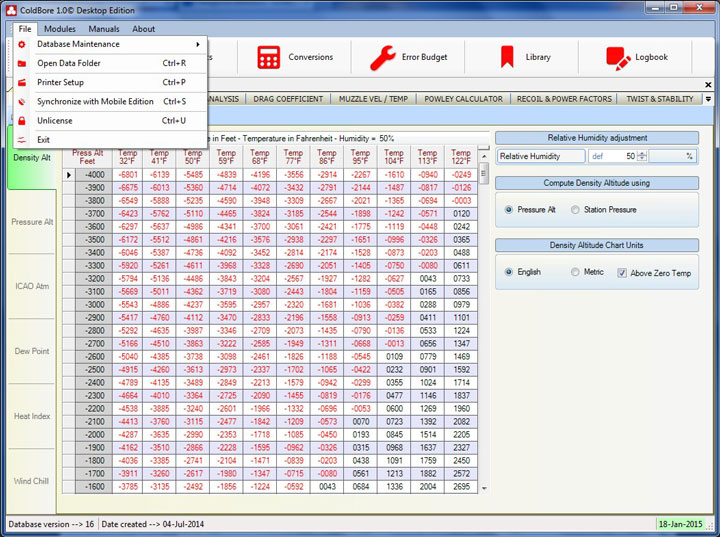D
Deleted member 113831
Guest
I may be the only one on here who actually wants this, but here goes:
There have been several threads and mentioned instances on this forum concerning either phones that have gotten destroyed, or lost, or just outdated. These phones contained much valuable ballistic data that must be either redone, or recovered (hopefully) from whatever device it was on.
Now, this is a great argument for keeping all your hard earned and expensively validated data on a hard copy such as in a dope book...I'm totally on board with that and have been a proponent of that for as long as I have been shooting. However, I would like something even more than that.
I would like a modern set of ballistics tables ranging from about .400 G1 BC to .800 G1 BC, covering altitudes from sea level to 10,000 ft elevation. I would like them to cover temp ranges from 0*F to 120*F. Another alternative would to somehow alter or divide up Marc Taylor's (@Enough Said) Weaponized Math charts by tailoring them more specifically for particular BC ranges and altitudes.
There would be an accompanying comprehensive list of longrange bullets in the index with their associated G1/G7 BC's. There could even be pictures of the bullets, so that if you had an unknown bullet...you could go to the table and find the diameter, the weight, and measure the length of ogive and boattail and at least get and idea of about what kind of BC you are dealing with (manner a la Litz).
The idea is that without electronics, I could reference the index for my bullet BC, then choose the speed and altitude I will be shooting at and get a complete set of "try dope" out to at least 1k yards. Even if we lose our dope, most of us remember our BC, our speed, and at least one of our drops at distance. Matching up those points with a predictive printed chart would fill in the blanks we don't remember, making it easy to "back into" the work recovering what we have already done.
There have always been some of the loading manuals that had some very basic ballistics tables in the back. But, they usually only went to 500 yards, and they typically list the drop in inches rather than angular measures.
I know that everyone is into their electronics, I know that this will not be as accurate as predictive software...I get it. I do wonder if the time is coming when these types of programs will be illegal and banned. Then what?
I'm probably gonna get hammered for posting this, but what says The Hide? Flame On!
There have been several threads and mentioned instances on this forum concerning either phones that have gotten destroyed, or lost, or just outdated. These phones contained much valuable ballistic data that must be either redone, or recovered (hopefully) from whatever device it was on.
Now, this is a great argument for keeping all your hard earned and expensively validated data on a hard copy such as in a dope book...I'm totally on board with that and have been a proponent of that for as long as I have been shooting. However, I would like something even more than that.
I would like a modern set of ballistics tables ranging from about .400 G1 BC to .800 G1 BC, covering altitudes from sea level to 10,000 ft elevation. I would like them to cover temp ranges from 0*F to 120*F. Another alternative would to somehow alter or divide up Marc Taylor's (@Enough Said) Weaponized Math charts by tailoring them more specifically for particular BC ranges and altitudes.
There would be an accompanying comprehensive list of longrange bullets in the index with their associated G1/G7 BC's. There could even be pictures of the bullets, so that if you had an unknown bullet...you could go to the table and find the diameter, the weight, and measure the length of ogive and boattail and at least get and idea of about what kind of BC you are dealing with (manner a la Litz).
The idea is that without electronics, I could reference the index for my bullet BC, then choose the speed and altitude I will be shooting at and get a complete set of "try dope" out to at least 1k yards. Even if we lose our dope, most of us remember our BC, our speed, and at least one of our drops at distance. Matching up those points with a predictive printed chart would fill in the blanks we don't remember, making it easy to "back into" the work recovering what we have already done.
There have always been some of the loading manuals that had some very basic ballistics tables in the back. But, they usually only went to 500 yards, and they typically list the drop in inches rather than angular measures.
I know that everyone is into their electronics, I know that this will not be as accurate as predictive software...I get it. I do wonder if the time is coming when these types of programs will be illegal and banned. Then what?
I'm probably gonna get hammered for posting this, but what says The Hide? Flame On!
Last edited by a moderator:


